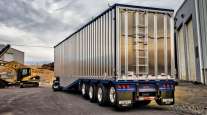Senior Reporter
Trailer Orders Rise 82% in February to 24,200

[Stay on top of transportation news: Get TTNews in your inbox.]
U.S. trailer orders in February reached 24,200, an increase of 82% from a year earlier, ACT Research reported, citing trailer makers’ preliminary data.
A year earlier, net orders were 13,279, according to ACT.
Leading trailer makers in March reported backlogs reach to the end of the year, and staffing and parts issues remain a challenge to varying degrees.
Preliminary U.S. trailer orders moderated in February, falling 23% m/m to 23,100 units. Orders were still 64% above February last year. @TruckForecast “2021 will be another fantastic year for the trailer industry once the supply chain stabilizes." https://t.co/poMYFdTr6E — FTR | Transportation Intelligence (@FTRintel) March 12, 2021
“I think you are seeing headwinds from some of the fleets with regard to ordering out that far, and I think there are trailer makers having the same concern,” Frank Maly, director of commercial vehicle transportation analysis and research at ACT, told Transport Topics.
“It would seem that the component challenges we are, and have been, facing will likely last longer than anyone considered originally,” said Sean Kenney, chief sales officer at Hyundai Translead.
He suggested a correction won’t come until the global economy opens more post-COVID.
Kenney said given the strong freight market, there are many customers who are dissatisfied with the industry’s current ability to provide equipment, “which is unfortunate for all of us.”
Craig Bennett, senior vice president of sales at Utility Trailer Manufacturing Co., suggested another wrinkle.
“The trailer market remains strong,” he said, “but much higher costs currently being implemented may slow down the growth rate of new orders.”
Add to that, many materials remain problematic, Bennett said, and hiring remains challenging also. “We are still working to increase trailer output as much as these limitations will allow. I expect these conditions to remain for the foreseeable future.”
The trailer market remains strong, but much higher costs currently being implemented may slow down the growth rate of new orders.
Craig Bennett, Utility Trailer Manufacturing Co.
Meanwhile, trailer makers’ major concern, Maly said, is building out the commitments they have. And there are still commitments that haven’t turned into orders yet, he added. “All that is going to do is push the backlog horizon out if we can’t get the production rates up.”
FTR pegged the preliminary trailer orders at 23,100.
Trailer makers were able to do “OK in February, comparatively,” said Don Ake, vice president of commercial vehicles at FTR. But he believes the industry to be in a very difficult situation for a few months.
Ake acknowledged that was an optimistic perspective on surging demand, supply chain disruptions and large backlogs.
“The trailer makers have already been dealing with these complications since last year,” he said. “We can’t see the end, but that doesn’t mean it goes on forever.”
The trailer backlog is out as far as he can remember, said David Giesen, vice president of sales at Stoughton Trailers. Plus, demand remains very strong and looks to continue strong all year and into next year.
But customers, he added, “want more and faster than we can produce.”
At Great Dane, it’s much the same.
“While we’ve not opened up 2022 production yet, there is demand from customers stating they need equipment next year at elevated volumes,” said Chris Hammond, the company’s executive vice president of sales.
“Basically van and reefer builds will be at industry capacity based upon whatever constraints slow us down,” he said.
Maly said platform trailers were showing signs of revival after a slump in 2020.
Great Dane’s flatbed line has shown more life over the past few months, agreed Hammond. “But not like 2018 and 2019 when flatbed builds were north of 30,000 units.”
The company currently has a new flatbed in testing that features lower weight components and a new side rail design.
The housing sector is a key market for fleets using flatbeds, as well as dry vans loaded with home goods.
“While single-family starts for the first two months of the year are 6.4% higher than the first two months of 2020, there has been a 36% gain over the last 12 months of single-family homes permitted but not started as some projects have paused due to cost and availability of materials,” said Robert Dietz, chief economist at the National Association of Home Builders.
Single-family home building is forecast to expand in 2021, Dietz said, but it will be at a slower rate as housing affordability is challenged by higher mortgage rates and rising construction costs.
Home construction stalled in February. Total housing starts fell 10.3% to an annual rate of 1.42 milliom. Single-family home starts declined 8.5 to an annual rate of 1.04 million. | #realestate #homebuilding pic.twitter.com/vrPHP7iYoG — NAHB (@NAHBhome) March 17, 2021
At the same time, two trailer makers said demand for intermodal equipment was strong.
Chassis have shown a very similar strong demand as dry vans, Giesen said.
Hyundai Translead’s Kenney agreed.
“The chassis product continues to be strong in the marketplace. Between quality offerings, congested supply chains, and very high equipment demand,” he said, “our intermodal product offering is enjoying a rather strong resurgence within our portfolio.”
Hammond said Great Dane is also seeing a revival in the truck bodies market.
“We’ve seen truck bodies pick up since the end of 2020,” he said, “meaning that segment is in recovery now.”
Want more news? Listen to today's daily briefing below or go here for more info:





